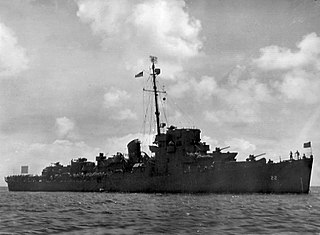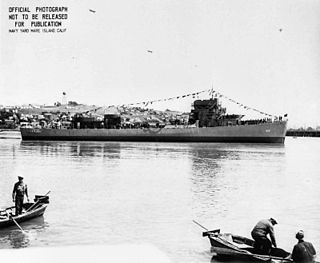
USS O'Flaherty (DE-340) was a John C. Butler-class destroyer escort built for the United States Navy during World War II. She was named for Ensign Frank Woodrow O'Flaherty, a pilot who posthumously received the Navy Cross for his actions at the Battle of Midway.

The third USS Macdonough (DD-351) was a Farragut-class destroyer in the United States Navy during World War II. She was named for Thomas Macdonough.

The second USS Fleming (DE-32), and first ship of the name to enter service, was an Evarts-class destroyer escort built for the United States Navy during World War II. While performing convoy and escort duty in the Pacific Ocean she was also able to sink one Japanese submarine and to shoot down several kamikaze planes that intended to crash onto her. For her military prowess under battle conditions, she was awarded four battle stars.

USS Sederstrom (DE-31) was a Evarts-class destroyer escort of the United States Navy during World War II. She was promptly sent to the Pacific Ocean to escort convoys and to protect other ships from Japanese planes and submarines. Her assignments took her from one battle area to another, but she was fortunate in remaining almost unscathed by the end of the war. For her efforts in battle areas, she was awarded five battle stars by war's end.

USS Burden R. Hastings (DE-19) was an Evarts-class destroyer escort of the United States Navy during World War II. Immediately after being built, she was crewed and sent to the Pacific Ocean to escort convoys and to protect them from air and submarine attack. During her wartime service, she was credited with having sunk one Japanese submarine and otherwise protecting numerous ships from danger. She was awarded four battle stars for her services in battle areas.

USS LeHardy (DE-20) was an Evarts-class destroyer escort constructed for the United States Navy during World War II. It was promptly sent off into the Pacific Ocean to protect convoys and other ships from Japanese submarines and fighter aircraft. At the end of the war, she had the honor of proceeding to Wake Island, as the Japanese commander surrendered, and raising a flagpole to fly the American flag once again.

USS Wileman (DE-22) was an Evarts-class destroyer escort constructed for the United States Navy during World War II. It was promptly sent off into the Pacific Ocean to protect convoys and other ships from Japanese submarines and fighter aircraft. At the end of the war, she returned to the United States proudly displaying four battle stars.

USS Whitman (DE-24) was an Evarts-class destroyer escort constructed for the United States Navy during World War II. It was promptly sent off into the Pacific Ocean to protect convoys and other ships from Japanese submarines and fighter aircraft. By the end of the war, when she returned to the United States, she had accumulated four battle stars.

USS Wintle (DE-25) was an Evarts-class destroyer escort constructed for the United States Navy during World War II. It was promptly sent off into the Pacific Ocean to protect convoys and other ships from Japanese submarines and fighter aircraft. By the end of the war, when she returned to the United States, she was awarded three battle stars.
The second USS Dempsey (DE-26) was an Evarts-class destroyer escort constructed for the United States Navy during World War II. She was promptly sent off into the Pacific Ocean to protect convoys and other ships from Japanese submarines and fighter aircraft. By the end of the ship's World War II service career, when she returned to the United States, she had accumulated three battle stars.

USS Emery (DE-28) was an Evarts-class destroyer escort constructed for the United States Navy during World War II. It was promptly sent off into the Pacific Ocean to protect convoys and other ships from Japanese submarines and fighter aircraft. By the end of the war, she had accumulated three battle stars.

The second USS Tisdale (DE-33) was an Evarts-class destroyer escort of the United States Navy during World War II. She was promptly sent off into the Pacific Ocean to protect convoys and other ships from Japanese submarines and fighter aircraft. She performed dangerous work in numerous battle areas, and was awarded four battle stars.

USS Manlove (DE-36) was an Evarts-class destroyer escort of the United States Navy during World War II. She was promptly sent off into the Pacific Ocean to protect convoys and other ships from Japanese submarines and fighter aircraft. She performed dangerous work in numerous battle areas, and was awarded five battle stars.

USS Brackett (DE-41) was an Evarts-class destroyer escort of the United States Navy during World War II. She was sent off into the Pacific Ocean to protect convoys and other ships from Japanese submarines and fighter aircraft. She performed escort and anti-submarine operations in dangerous battle areas and was awarded three battle stars.

USS Reynolds (DE-42) was an Evarts-class destroyer escort constructed for the United States Navy during World War II. She was sent off into the Pacific Ocean to protect convoys and other ships from Japanese submarines and fighter aircraft. She performed escort and antisubmarine operations in dangerous battle areas and was awarded eight battle stars, a very high number for a ship of her type.

USS Donaldson (DE-44) was an Evarts-class destroyer escort of the United States Navy during World War II. She was sent off into the Pacific Ocean to protect convoys and other ships from Japanese submarines and fighter aircraft. She performed escort and anti-submarine operations in dangerous battle areas and was awarded seven battle stars, a very high number for a ship of her type.

USS William C. Miller (DE-259) was an Evarts-class destroyer escort constructed for the United States Navy during World War II. She was sent off into the Pacific Ocean to protect convoys and other ships from Japanese submarines and fighter aircraft. She performed escort and anti-submarine operations in dangerous battle areas and returned home with seven battle stars, a very high number for a ship of her type.

USS Dionne (DE-261) was an Evarts-class destroyer escort of the United States Navy during World War II. She was sent off into the Pacific Ocean to protect convoys and other ships from Japanese submarines and fighter aircraft. She performed escort and antisubmarine operations in dangerous battle areas and returned home with six battle stars, a high number for a ship of her type.

USS Cloues (DE-265) was an Evarts-class destroyer escort of the United States Navy during World War II. She was sent off into the Pacific Ocean to protect convoys and other ships from Japanese submarines and fighter aircraft. She performed escort and antisubmarine operations in dangerous battle areas and returned home with three battle stars.

USS Climax (AM-161) was an Admirable-class minesweeper built for the U.S. Navy during World War II. She was built to clear minefields in offshore waters, and served the Navy in the Pacific Ocean.



















